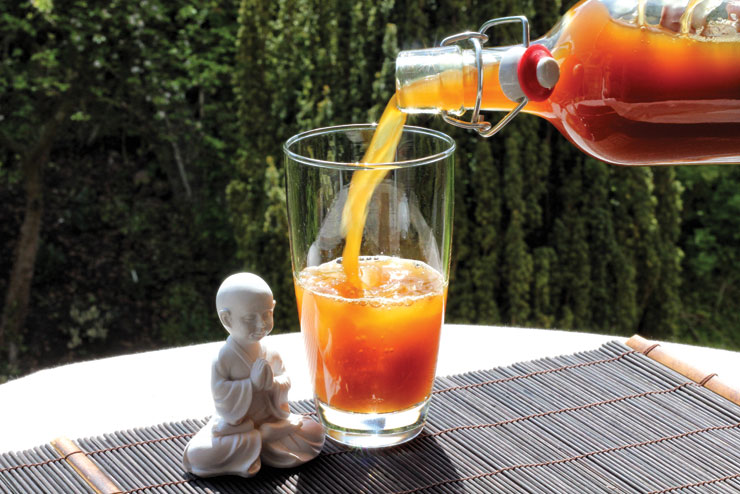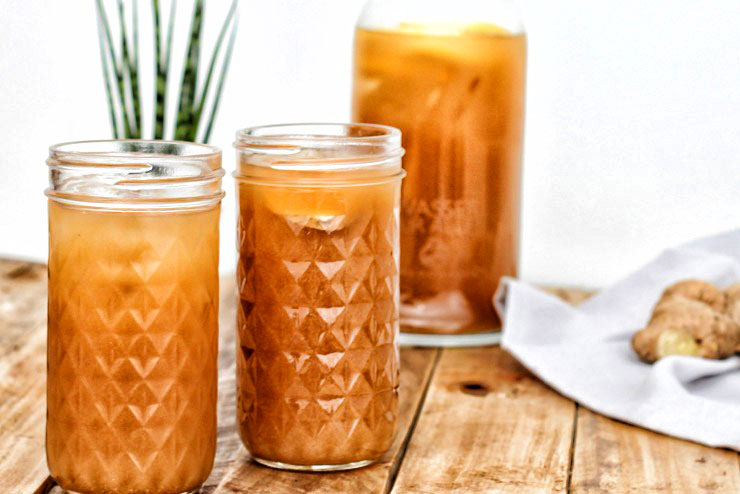Kefir, milk kefir, kombucha, sauerkraut, do it yourself, fermentation, e-book, book.” width=”740″ height=”494″ /> Simply make kefir, kombucha, sauerkraut & Co. yourself. With lots of tips and tricks.[/caption]
Second fermentation with kombucha - a fizzy and tasty drink adventure
Print RecipeIngredients
- Glass bottle for 1 liter with swing top
- 1 liter selfmade and active kombucha
- 5 slices of ginger
- 1 finely chopped fig
Instructions
Slice 5 thick pieces of a ginger
Cut fig into small pieces
Put all ingredients into the bottle and close it carefully
Let it ferment on room temperature for a few days. Please make sure to check the pressure of the bottle daily!
Schon ist dein leckerer Ingwer und Feige Kombucha aus der zweit Fermentation fertig und du kannst ihn in schöne Gläser geben und sofort genießen.
Ich wünsche euch viel Spaß beim nachmachen und genießen 🙂
Bis bald zu den nächsten Rezepten mit Kefir oder Kombucha…
Eure Petra
Schaut euch doch auch mal dieses Video über Kombucha Tee und ganz viele andere auch gerne auf meinem Youtube-Kanal an…
* dies ist ein Affiliate-Link – Bei Affiliatelinks handelt es sich um WerbelinksHello my dears,
I am very sure about the fact that you have already heard something about second fermentation on the internet.
But what is second fermentation and does it make such a big difference when it comes to taste and flavour? Learn more….
 Order your organic kombucha here and start brewing your own kombucha*
Order your organic kombucha here and start brewing your own kombucha*
Kombucha with fruits, dried fruits and spices is an everyones dream. But most of you also know that your kombucha scobys or kombucha drink is very sensitive especially at the first batch. As I already said in in our article about kombucha and mold, those mushroom cultures can be very susceptible to germs. Fruits and other added ingredients could harm the kombucha by bringing pathogens into the tea mushroom drink. But this is not an obstacle to make a tasty kombucha drink with fruits in the second step.
In the second fermentation of kombucha we only use the drink we made. The scoby is going to a new normal kombucha batch and stays inside his old home. The finished drink goes into a resealable bottle and can be added with all ingredients and flavours you like. After adding all those tasty things make sure you close the bottle carefully. Yes, I wrote the right thing, in the second fermentation it is necessary to close the bottle instead of using a breathable cloth to cover your kombucha drink.
The reason why: In this case, we want to avoid another acidification of the drink. The kombucha cultures are working aerobic (which means they need oxygen) with closing the bottle we make those cultures stop working and stop the acidification of those bacteria.
But the yeast bacteria inside the drink are able to work without oxygen. They are anaerobically. As a result, carbon dioxide and alcohol are formed in the beverage with further breakdown of sugar. In combination with water, the carbon dioxide forms carbonic acid and makes your kombucha drink beautifully fizzy.
For making you start right away, we have some important security instructions for you.
- Please use high quality glass bottles only for the fermentation process. We recommend you to use a bottle with swing top. You can easily order here*. Sometimes in second fermentation the pressure inside the glass gets very high. That’s why you should not use plastic bottles of any kind because they can literally explode and splinter.
- Check out the pressure of your drink. We advise you to do this daily. Just open the bottle for a few seconds and allow the gas to escape. This procedure lowers the risk of an exploding glass bottle.
Now you are ready to start! For making the beginning easier, I have my favourite kombucha second fermentation recipe for you:
For this easy second fermentation kombucha, ginger and fig drink you need those ingredients
- Glass bottle for 1 liter with swing top*
- 1 liter selfmade and active kombucha – my delicious organic kombucha waits here* for you
- 5 slices of ginger
- 1 finley chopped fig*
This is how to make your fizzy kombucha drink with ginger and figs recipe yourself!
- Slice 5 thick pieces of a ginger
- Cut fig into small pieces
- Put all ingredients into the bottle and close it carefully
- Let it ferment on room temperature for ca. 3 days. Please make sure to check the pressure of the bottle daily!

- Enjoy 🙂
Second fermentation with kombucha - a fizzy and tasty drink adventure
Print RecipeIngredients
- Glass bottle for 1 liter with swing top
- 1 liter selfmade and active kombucha
- 5 slices of ginger
- 1 finely chopped fig
Instructions
Slice 5 thick pieces of a ginger
Cut fig into small pieces
Put all ingredients into the bottle and close it carefully
Let it ferment on room temperature for a few days. Please make sure to check the pressure of the bottle daily!
On a warm day the drink tastes especially nice with some crushed ice.
Have fun whilst cooking and enjoy!
I wish you a lot of fun by making this kombucha second fermentation recipe and I am very excited to hear your opinions about this delicious scoby recipe.
I would love to see some comments about your favourite recipes with kombucha tea and how you liked mine.
I am looking forward to see you again for my next recipes.
Petra
Watch also this video and many more regarding Kefir and Kombucha on my Youtube channel…
* This is an Affiliate-Link – Affiliate-Links are sponsored Links


15 Comments
Maria Zellner
Sunday February 3rd, 2019 at 01:40 AMIch habe zwar noch keine Zweitfermentation versucht, aber ich fülle den Kombucha in Bügelflaschen ab und bewahre ihn ein paar Wochen lang auf, bevor ich ihn trinke. Da entsteht dann auch manchmal jede Menge Kohlensäure, so dass das Öffnen einige Zeit in Anspruch nimmt (öffnen, dann schnell wieder schließen, bevor es heraussprudelt, und das Ganze einige Male wiederholen). Mir ist jedoch in 15 Jahren noch nie passiert, dass eine Flasche geplatzt ist. Daher denke ich nicht, dass es bei Bügelflaschen nötig ist, jeden Tag zwecks Druckausgleich die Flasche kurz zu öffnen.
Petra
Friday March 15th, 2019 at 12:45 PMLiebe Maria,
vielen Dank für Ihre hilfreichen Kommentar. Wir empfehlen unseren lieben Lesern lieber den Druckausgleich – einfach aus Sicherheitsgründen.
Liebe Grüße und viel Spaß beim Fermentieren,
Petra
Hannah
Friday February 7th, 2020 at 04:09 PMHallo Petra ,
ich kann Ihrer Empfehlung nur zustimmen, denn mir ist es jetzt bereits drei Mal passiert, dass mir eine Flasche bei der Zweitfermentation geplatzt ist und das zum Teil böse Auswirkungen hatte. Hierbei sei aber auch zu erwähnen, dass mein Kombucha bereits beim Erstansatz enorm sprudelt. Seitdem verwende ich keine Bügelverschlüsse mehr, sondern Wein- und Milchflaschen. Mir ist nie wieder eine Flasche geplatzt. Ausserdem haben diese Flaschen den Vorteil, dass sich die Deckel nach oben wölben und ich sehen kann, dass eine”Entlüftung” notwendig ist.
Beste Grüße
Petra
Sunday February 16th, 2020 at 10:02 PMLiebe Hannah,
das ist ein hervorragender Ansatz.
Weiterhin viel Erfolg beim Kombucha brauen:-)
Liebe Grüße
Petra & Stephan
Maria
Sunday February 16th, 2020 at 10:28 PMDie Verwendung von Milchflaschen leuchtet mir ein; bei Twist-off-Deckeln entweicht der Druck, wie ich bei Eingekochtem, das zu Gären anfing, feststellen konnte. Aber Weinflaschen? Da ist doch entweder ein Kork drauf, der bei zu großem Druck explosionsartig in die Luft geschleudert wird und der Inhalt heraussprudelt, oder es ist ein Schraubverschluss, der, wenn er zugedreht ist, keinen Druckausgleich bietet und daher die Gefahr des Platzens m. E. relativ groß ist. Auch ist bei den kleinen Schraubdeckeln nicht leicht erkennbar, wenn in der Flasche Überdruck herrscht und man Druck ablassen sollte, ganz abgesehen davon, wenn man es mal vergisst. Man könnte höchstens, wie bei den gekauften Federweißer-Flaschen den Deckel nur lose aufdrehen; aber wenn ich ordentlich Kohlensäure erzeugen möchte, ist das nicht zielführend.
Oliver
Saturday August 10th, 2019 at 01:53 PMDie Zusätze erhöhen die Kohlensäurebildung, insbesondere bei süßen Früchten kann sich da ein enormer Druck entwickeln. Auch die Temperatur spielt eine große Rolle. Deshalb würde ich die Flaschen lieber täglich kurz mal vorsichtig öffnen.
Petra
Sunday August 11th, 2019 at 08:42 PMLieber Oliver,
ja, das stimmt. Es entsteht Druck und die Kohlensäurebildung erhöht sich mit zunehmender Termperatur wenn genügend Zucker vorhanden ist. Täglich nachgucken ist auch in Ordnung!
Vielen Dank für Ihren Hinweis:-)
Wir wünschen weiterhin viel Freude beim Fermentieren!
Herzliche Grüße
Petra & Stephan
Lena Saalfrank
Tuesday September 24th, 2019 at 08:17 AMLiebe Petra,
vielen Dank für das Rezept!
Lässt du denn den Ingwer und die Feige dann in der Flasche weiterziehen, oder fischst du die nach der 2. Fermentation dann wieder raus?
LG Lena
Petra
Tuesday September 24th, 2019 at 09:32 AMLiebe Lena,
vielen Dank für Deinen Kommentar!
Für die Zweite Fermentation nimmst Du fertigen Kombucha aus der ersten Fermentation und gibst dann frischen Ingwer und Feigen (oder auch andere Früchte Deiner Wahl) hinzu. Diese Fermentations Mischung gärt dann je na Geschmack ca. 3 Tage in einer Flasche oder einem anderen Gärgefäß. Wenn Du den leckeren Kombucha dann trinken möchtest, kannst Du die Feigen und Ingwerstücke dann für den nächsten Ansatz nutzen oder frische nehmen. Beide Varianten sind möglich. Der Geschmack ist mit frischen Früchten und Ingwer natürlich wesentlich intensiver. Aber da kannst Du auch etwas experimentieren:-)
Wir wünschen viel Freude beim Fermentieren:-)
Liebe Grüße
Petra
Birgit Vahle
Tuesday December 1st, 2020 at 04:21 PMHallo Petra,
ich habe die zweite Fermantation schon 3 mal versucht, miit Ingwer und Zitronensaft und einmal mit Rosinen. Leider bildet sich bei mir keine Kohlensäure (und die Süße nimmt leider auch nicht ab). Hast du vielleicht noch einen Tipp für mich?
Ansonsten kann ich dieses “Haustier” nur wärmstens empfehlen, das fertige Getränk ist einfach köstlich.
Liebe Grüße
Birgit
Petra
Wednesday December 2nd, 2020 at 06:46 PMLiebe Birgit,
vielen Dank für Ihren Kommentar!
Haben Sie die Flasche verschlossen und bei Zimmertemperatur stehen lassen? Sofern die Kohlensäure nicht entweichen kann wird Sie im Kombucha gebunden und sorgt für herrliches prickeln… Vielleicht auch etwas länger stehen lassen…?
Viel Erfolg beim Fermentieren!
Herzliche Grüße
Petra & Stephan Kriegener
Melissa M
Friday December 18th, 2020 at 02:06 PMIn diesem Artikel steht, dass “Hefebakterien” für die zweit Fermentation verantwortlich ist. Es gibt keine Hefebakterien! Hefe ist ein einzelliger Pilz.
Genau wie beim Bier und jungem Wein sorgen diese für den Alkohol und die Kohlensäure.
Petra
Thursday January 14th, 2021 at 12:13 PMLiebe Melissa,
vielen Dank für Ihren Hinweis:-)
Herzliche Grüße
Petra & Stephan Kriegener
Babs G
Tuesday May 24th, 2022 at 04:49 PMHallo
ich möchte mich mit dem nächsten Ansatz auch mal mit der Zweitfermentation beschäftigen. 🙂
Ich frage mich, ob ich anstelle des gesamten Obstes (in Stücke oder Scheiben geschnitten) nicht auch einfach frisch ausgepressten Saft nehmen kann. Ich habe sowohl einen Kaltentsafter, als auch eine Presse zum kaltentsaften zuhause. Auch ein Dampfentsafter stände mir zur Verfügung.
Leider finde ich immer nur Rezepte, wo Obst und Gemüse als ganzes zerkleinert zur Zweitfermetation genutzt wird.
Hat das einen Grund?
Liebe Grüße
Babs
Petra
Monday May 30th, 2022 at 01:24 PMHallo Babs,
vielen Dank für Ihren lieben Kommentar!
Natürlich können Sie auch den Saft nutzen. In diesem Fall ist der Geschmack und das Aroma noch intensiver und noch mehr Zucker steht zur Verarbeitung zur Verfügung. Sie könnten den Kombucha nebst Ansatzflüssigkeit auch statt in gezuckerten Tee in Ihren selbst gepressten Saft geben. Das würde auch funktionieren.
Herzliche Grüße
Stephan Kriegener